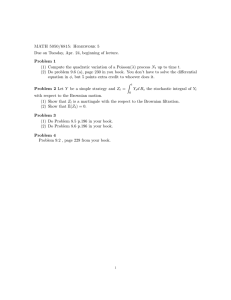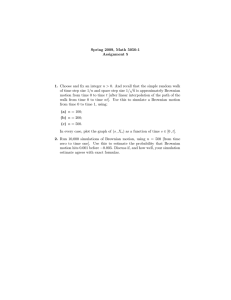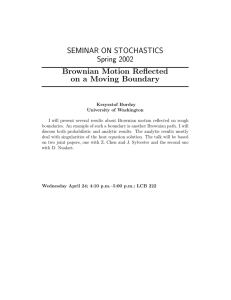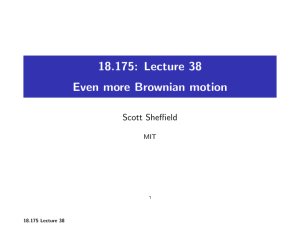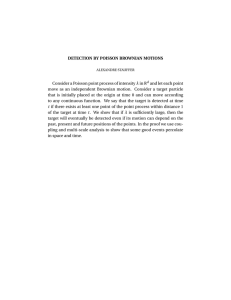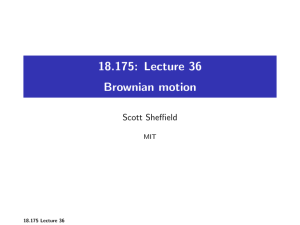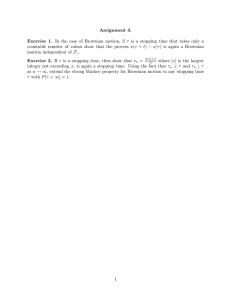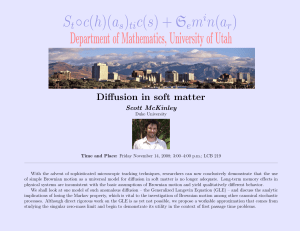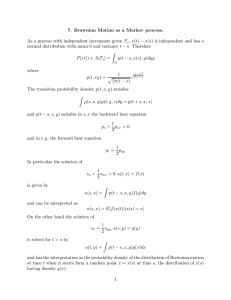Document 13424502
advertisement
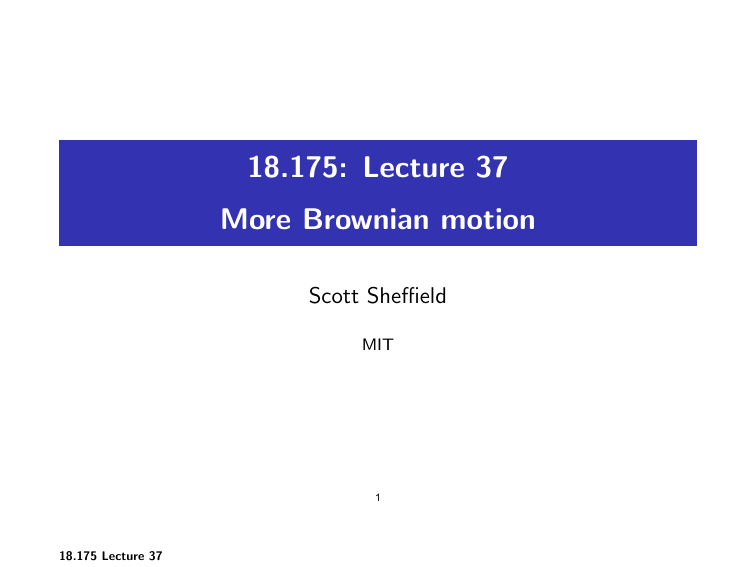
18.175: Lecture 37
More Brownian motion
Scott Sheffield
MIT
1
18.175 Lecture 37
Outline
Brownian motion properties and construction
Markov property, Blumenthal’s 0-1 law
2
18.175 Lecture 37
Outline
Brownian motion properties and construction
Markov property, Blumenthal’s 0-1 law
3
18.175 Lecture 37
Basic properties
�
Brownian motion is real-valued process Bt , t ≥ 0.
�
Independent increments: If t0 < t1 < t2 . . . then
B(t0 ), B(t1 − t0 ), B(t2 − t1 ), . . . are independent.
�
Gaussian increments: If s, t ≥ 0 then B(s + t) − B(s) is
normal with variance t.
�
Continuity: With probability one, t → Bt is continuous.
�
Hmm... does this mean we need to use a σ-algebra in which
the event “Bt is continuous” is a measurable?
�
Suppose Ω is set of all functions of t, and we use smallest
σ-field that makes each Bt a measurable random variable...
does that fail?
4
18.175 Lecture 37
Basic properties
�
I
Translation invariance: is Bt0 +t − Bt0 a Brownian motion?
�
I
Brownian scaling: fix c, then Bct agrees in law with c 1/2 Bt .
�
I
Another characterization: B is jointly Gaussian, EBs = 0,
EBs Bt = s ∧ t, and t → Bt a.s. continuous.
5
18.175 Lecture 37
Defining Brownian motion
�
I
Can define joint law of Bt values for any finite collection of
values.
�
I
Can observe consistency and extend to countable set by
Kolmogorov. This gives us measure in σ-field F0 generated by
cylinder sets.
�
I
But not enough to get a.s. continuity.
�
I
Can define Brownian motion jointly on diadic rationals pretty
easily. And claim that this a.s. extends to continuous path in
unique way.
�
I
We can use the Kolmogorov continuity theorem (next slide).
�
I
Can prove Hölder continuity using similar estimates (see
problem set).
�
I
Can extend to higher dimensions: make each coordinate
independent Brownian motion.
6
18.175 Lecture 37
Continuity theorem
�
I
Kolmogorov continuity theorem: Suppose
E |Xs − Xt |β ≤ K |t − s|1+α where α, β > 0. If γ < α/β then
with probability one there is a constant C (ω) so that
|X (q) − X (r )| ≤ C |q − r |γ for all q, r ∈ Q2 ∩ [0, 1].
�
I
Proof idea: First look at values at all multiples of 2−0 , then
at all multiples of 2−1 , then multiples of 2−2 , etc.
�
I
At each stage we can draw a nice piecewise linear
approximation of the process. How much does the
approximation change in supremum norm (or some other
Hölder norm) on the ith step? Can we say it probably doesn’t
change very much? Can we say the sequence of
approximations is a.s. Cauchy in the appropriate normed
spaced?
7
18.175 Lecture 37
Continuity theorem proof
�
I
Kolmogorov continuity theorem: Suppose
E |Xs − Xt |β ≤ K |t − s|1+α where α, β > 0. If γ < α/β then
with probability one there is a constant C (ω) so that
|X (q) − X (r )| ≤ C |q − r |γ for all q, r ∈ Q2 ∩ [0, 1].
�
I
Argument from Durrett (Pemantle): Write
Gn = {|X (i/2n ) − X ((i − 1)/2n )|} ≤ C |q − r |λ for 0 < i ≤ 2n }.
�
I
Chebyshev implies P(|Y | > a) ≤ a−β E |Y |β , so if
λ = α − βγ > 0 then
P(Gnc ) ≤ 2n · 2nβγ · E |X (j2−n )|β = K 2−nλ .
8
18.175 Lecture 37
Easy observations
�
I
Brownian motion is Hölder continuous for any γ < 1/2 (apply
theorem with β = 2m, α = m − 1).
�
I
Brownian motion is almost surely not differentiable.
�
I
Brownian motion is almost surely not Lipschitz.
�
I
Kolmogorov-Centsov theorem applies to higher dimensions
(with adjusted exponents). One can construct a.s. continuous
functions from Rn to R.
9
18.175 Lecture 37
Outline
Brownian motion properties and construction
Markov property, Blumenthal’s 0-1 law
10
18.175 Lecture 37
Outline
Brownian motion properties and construction
Markov property, Blumenthal’s 0-1 law
11
18.175 Lecture 37
More σ-algebra thoughts
�
I
Write Fso = σ(Br : r ≤ s).
�
I
Write F
s+ = ∩t>s Fto
�
I
Note right continuity: ∩t>s Ft+ = F
s+ .
�
I
F
s+ allows an “infinitesimal peek at future”
12
18.175 Lecture 37
Markov property
�
I
If s ≥ 0 and Y is bounded and C-measurable, then for all
x ∈ Rd , we have
Ex (Y ◦ θs |Fs+ ) = EBs Y ,
where the RHS is function φ(x) = Ex Y evaluated at x = Bs .
�
I
Proof idea: First establish this for some simple functions Y
(depending on finitely many time values) and then use
measure theory (monotone class theorem) to extend to
general case.
13
18.175 Lecture 37
Looking ahead
I
�
Theorem: If Z is bounded, measurable then for s ≥ 0 have
Ex (A|Fs+ ) = Ex (Z |Fs0 ).
14
18.175 Lecture 37
Blumenthal’s 0-1 law
�
I
If A ∈ F0+ , then P(A) ∈ {0, 1} (if P is probability law for
Brownian motion started at fixed value x at time 0).
�
I
There’s nothing you can learn from infinitesimal neighborhood
of future.
15
18.175 Lecture 37
MIT OpenCourseWare
http://ocw.mit.edu
18.175 Theory of Probability
Spring 2014
For information about citing these materials or our Terms of Use, visit: http://ocw.mit.edu/terms .
